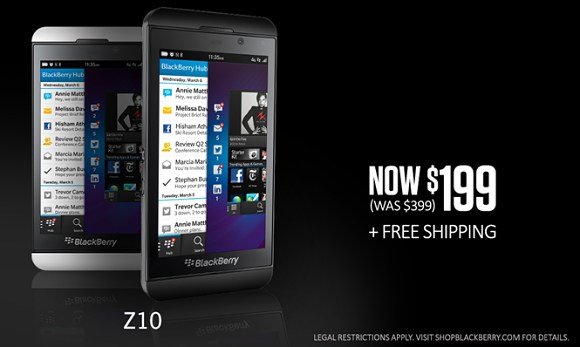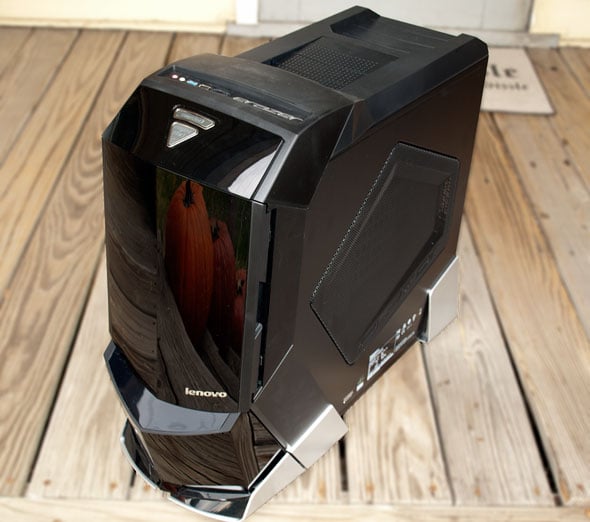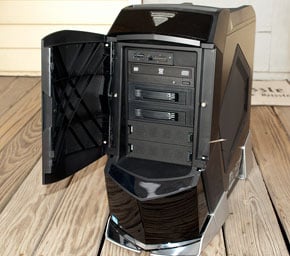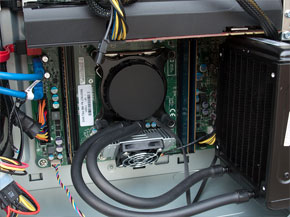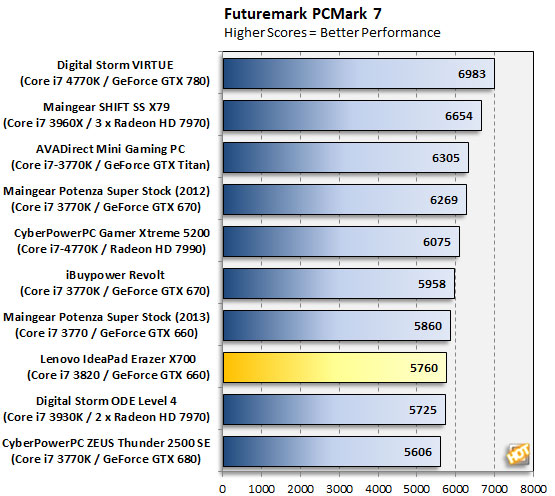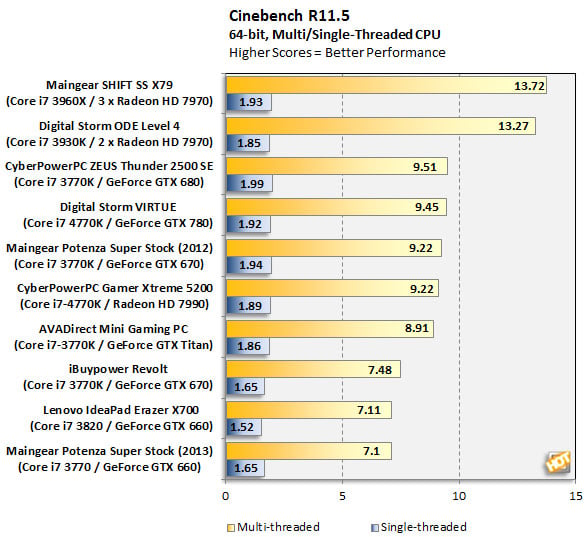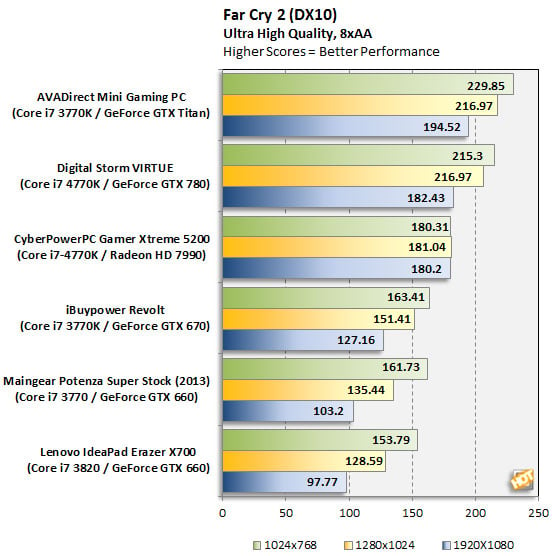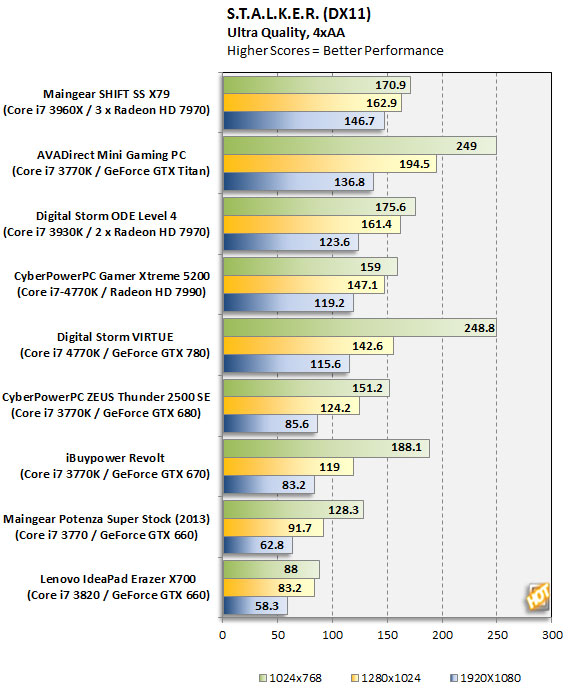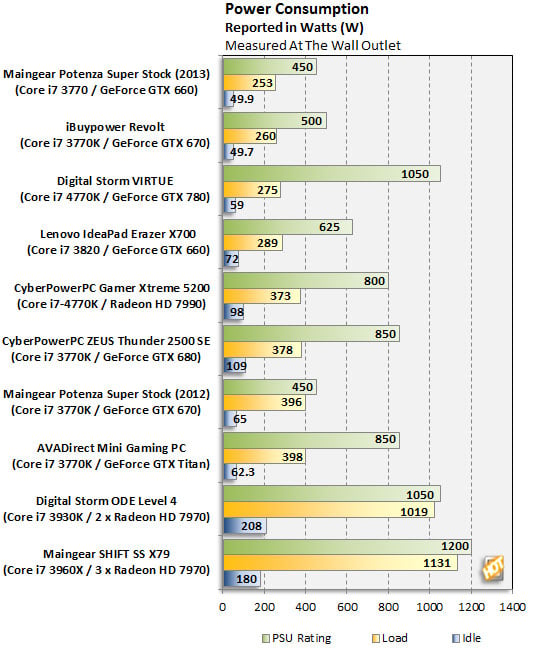If we asked you to name five gaming PC manufacturers,
Lenovo probably wouldn't make the list. No other company in the world ships more PCs than Lenovo, but of those machines, relatively few are dedicated gaming boxes. Traditionally, Lenovo has focused its efforts on business class desktops and laptops, though the company is known to play in performance waters on occasion, most notably with its IdeaCentre K Series of high-end towers. These aren't hardcore gaming boxes like the boutique builders offer, however, so there's room in Lenovo's lineup to add a dedicated line of systems built exclusively for gamers, and that's what we have with the IdeaCentre Erazer X700.
This is a big system at 24.01 inches (L) by 10.62 inches (W) by 20.86 inches (H), and weighing north of 61 pounds. It's also decidedly more menacing in appearance than your standard desktop tower, leaving little doubt who the target audience is. Just in case further proof is needed, blue LEDs adorn the front and shine through the side panel's mesh window, flaunting the fact that this is a gaming box and not a number crunching machine for accountants, though it's certainly capable of doing your taxes just as a Dodge Challenger can be a grocery-getter.
 | | Lenovo IdeaCentre Erazer X700 | | Specifications & Features | |
| Processor: | Intel Core i7 3820 Quad-Core 3.6GHz (3.8GHz Turbo; 10MB cache) |
| Memory: | 12GB 1600MHz DDR3 (4GB x 3) |
| Graphics: | NVIDIA GeForce GTX 660 1.5GB GDDR5 |
| Chipset: | Intel X79 |
| Storage: | Samsung 128GB mSATA solid state drive
Seagate Barracuda 1TB hard drive (7200 RPM, 64MB cache) |
| Optical: | DVD burner |
| Power Supply: | AcBel Polytech 625W |
| Cooling System: | Self contained liquid cooler |
| Connectivity: | Gigabit LAN; Wi-Fi (802.11b/g/n/) |
| Front Ports: | Power button; Overclocking button; USB 3.0 (x1); USB 2.0 (x1); Mic/Heaphone; 29-in-1 card reader |
| Rear Ports: | USB 3.0 (x2); USB 2.0 (x6); HDMI output; DisplayPort; DVI (x2) |
| Operating System: | Windows 8 64-bit |
| Accessories: | Keyboard and mouse |
| Dimensions: | 24.01 inches by 10.62 inches by 20.86 inches; 61.72 pounds |
| Warranty: | 1-year |
| Price: | $1,699.99 |
The configuration Lenovo sent us is its lowest end setup
starting at $1,699 (we've seen Lenovo sell this system as low as $1,349 on its website with an eCoupon code). Interestingly, Lenovo opted for a Sandy Bridge-E foundation over Haswell, though it's hard to begrudge the raw performance Intel's Core i7 3820 quad-core processor brings to the table. At the same time, it sets a tone of compromise that continues with the NVIDIA GeForce GTX 660 graphics card selection rather than a higher end GPU, and 12GB of DDR3-1600 RAM spread across three modules in triple-channel mode as opposed to adding a fourth stick for quad-channel operation, which Intel's X79 chipset supports.
On the storage front, Lenovo paired a Samsung 128GB mSATA solid state drive with a Seagate Barracuda 1TB hard drive (7200 RPM, 64MB cache) for fast loads and sufficient space to hold a decent amount of data. None of this is cause for your jaw to fall to the floor, though higher end configurations are available, including a decked out system that costs $3,999.
One of the more interesting aspects of the Erazer X700 is an "Overclocking" button on the front panel that sits directly above the "Engine Start" button. When pressed, the Overclock button glows red and stays that way until you turn it off, though the system isn't necessarily overclocked at that point.
Lenovo includes a software utility that allows you to coax more performance out of the CPU without having to shuffle through the BIOS. You can only engage the software when the Overclocking button is pressed, at which point you can then adjust the CPU multiplier and other settings. Following a reboot, your settings will go into effect, assuming the system can handle the new parameters. If not, the motherboard catches fire, your system is ruined, and your wife runs off with the kids and dog leaving you to wonder how you could have been so careless (just kidding - it just reverts back to default settings).
Before we dive into this behemoth, we feel compelled to draw some attention to the keyboard and mouse combination Lenovo bundles in. The reason being, bulk OEMs have a nasty habit of giving gamers generic peripherals to work with, which would be like buying a sports car and driving off the lot with bald tires. Not Lenovo.
Instead of a generic plank and a dingbat mouse, Lenovo includes a gaming keyboard with an adjustable backlight and smooth key action, and a nine-button mouse with an adjustable weight system and on-the-fly DPI switching. Both products are gaming-centric in function and match the Erazer X700's style in form.
Other contents include the usual assortment of paperwork and a driver disc. What you don't get is a fancy binder performance metrics specific to your system or other accessories, like a t-shirt or whatever else the boutiques happen to be tossing in with their rigs these days.
Once you've unpacked the Erazer X700 and removed the plastic wrappings protecting the glossy finish, you can begin admiring the angled design, future-looking aesthetic Lenovo was clearly aiming for. With the LED lights shining through, the Erazer X700 crosses over into gaudy territory, though that's not necessarily a bad thing. This is a gaming system that looks the part, so we're willing to overlook the eccentric angles. As Lenovo explains it, the Erazer X700 is supposed to resemble a knight's armor with the front of the system taking the shape of a helmet and visor.
We like the inspiration but not the liberal use of plastic that adorns the entire front panel and top of the chassis. For this particular configuration it's not too egregious, but if you're springing for a higher end setup or going all out on the $3,999 version of the Erazer X700, all that plastic becomes a bit more vexing.
There's also lots of gloss on the front panel, and while we'd normally bring up the tendency of such finishes to attract finger smudges, the look works well with Lenovo's overall design. Not only is the glossy finish attractive, but it also helps you overlook the plastic construction. Besides, a quick wipe down with a lint-free cloth or even a sock will rid it of fingerprints and instantly restore its glossy luster.
In somewhat of a throwback to earlier days, the Erazer X700 features a door on the front panel. Behind the door you'll find the DVD burner as included here or a Blu-ray drive if opting for a more expensive model, two how-swap drive bays that can accommodate both 3.5-inch and 2.5-inch drives, and a 29-in-1 card reader. There's also room to add two more 5.25-inch peripherals, if desired.
On top of the system are the Overclock and Engine Start buttons we discussed earlier, along with a USB 3.0 port, USB 2.0 port, microphone jack, and headphone jack. There's also a covered eSATA port that isn't active/usable.
Around back you'll find two more USB 3.0 ports, half a dozen USB 2.0 ports, HDMI output, a DisplayPort, two DVI ports, GbE LAN port, and various audio jacks. There's also a place to install the included antenna for built-in 802.11n Wi-Fi.
Up on top of the system and tucked away towards the front is a plastic slab that pushes down to reveal a USB 3.0 B-type connector and power port. A protective plastic cover hides these ports, and also interferes with the slabs ability to bounce up and down. Just remove the cover and you're golden.
The side panel slides right off once you remove the two thumb screws holding it in place. Once you stick your head inside the chassis, you're quickly reminded the Erazer X700 is built by a bulk OEM and not a boutique builder. We won't go so far as to call the wiring job lazy, but it's certainly not neat. At least Lenovo bundles the wires in some places.
This is a bigger case than it needs to be. Lenovo's using a mini-ITX motherboard instead of a full-size ATX slab. Other than the wasted real estate (and perhaps the impact on performance, as we'll get to on the following pages), we don't have any issue with that decision because it can hold dual graphics cards in SLI or CrossFireX and has four DDR3 DIMM slots. You'll notice that only three of them are occupied (12GB total), so we're running in triple-channel mode.
There's room to add more drives as well as upgrade hardware down the line, such as a faster (and longer) graphics card. Just be aware that you're working with a 625W power supply.
We also like the water cooling scheme Lenovo went with. The Erazer X700 kept its cool and never got loud during testing, even during heavy loads.
To kick things off we fired up Futuremark's system performance benchmark, PCMark 7. This synthetic benchmark suite simulates a range of real-world scenarios and workloads, stressing various system subsets in the process. Everything you'd want to do with your PC -- watching HD movies, music compression, image editing, gaming, and so forth -- is represented here. Also, most of the tests are multi-threaded, making this a good indicator of all-around performance.
From there, we switched gears to 3DMark to get a feel for gaming potential before jumping into our gauntlet of real-world game benchmarks.
 | Futuremark PCMark 7
| Simulated Application Performance
| |

PCMark 7
| PCMark 7 runs through the types of tasks your PC is likely to encounter during ordinary home and office use. It tests the system’s graphics capabilities as well, but it isn’t mean to test the limits of high-end, discrete graphics card. Look at PCMark 7 as an indicator of a system’s general usage performance. |
The IdeaCentre Erazer X700 edged out a couple of systems in PCMark 7 though was still towards the bottom of the pack. What stands out is that it scored slightly lower than similarly equipped systems, and we have our hunches why. One of them is because the system is only running in triple-channel mode instead of quad-channel mode due to the inclusion of three DDR3 memory sticks instead of four. In addition, the mini-ITX motherboard probably isn't a performance model, nor is anything overclocked on this system. When you put those factors together, it would explain why the Erazer X700 runs a little slower than the competition.
 | | Futuremark 3DMark 11 | | Simulated Gaming Performance | |

3DMark 11
| Although Futuremark’s 3DMark 11 has been around for several years, it still provides a good look at a system’s gaming capabilities. It's also handy tool for benchmarking machines that still run Windows 7. We ran this benchmark on the Performance preset, at 1280 x 720 resolution. If you download the free version of this benchmark, make sure you're using the Performance preset to avoid comparing scores that were run with different test configurations.
|
The same story played out in 3DMark 11, though at first glance we were surprised the discrepancy between the Erazer X700 and Maingear Potenza was around 1,700 points. A closer look reveals that Maingear's system is running an overclocked MSI GeForce GTX 660 Twin Frozr III graphics card, versus the stock clocked model in Lenovo's rig. Maingear's system also has more RAM, a higher end motherboard, and an Ivy Bridge processor, all of which give it a performance advantage.
 | | Futuremark 3DMark Fire Strike | | Simulated Gaming Performance | |

3DMark Fire Strike
| The next test we ran was Futuremark’s newest: 3DMark Fire Strike is designed specifically for high-end gaming PCs like the Tiki. Because Extreme mode is geared towards systems that have multiple graphics cards in CrossFire or SLI configurations, we opted for Normal mode, which runs at 1920 x 1080.
|
Futuremark's 3DMark FireStrike tests had Lenovo's rig trailing Maingear by just a few frames per second, which isn't too bad considering the performance advantages mentioned above.
We continued our testing with SiSoftware's SANDRA, the
System
ANalyzer,
Diagnostic and
Reporting
Assistant. We ran four of the built-in subsystem tests (CPU Arithmetic, Multimedia, Memory Bandwidth, Physical Disks). We then tested the system with Cinebench, a content creation performance benchmark.
 | | SiSoft SANDRA | | Synthetic Benchmarks | |

SiSoft SANDRA
| SiSoft SANDRA has a variety of tests that stress specific components or simulate certain tasks. We put the Falcon Northwest Tiki through the CPU Arithmetic, Multimedia, Memory Bandwidth, and Physical Disks tests.
|

Here we see the Erazer X700 manage to move up a few spots, at least in terms of multimedia performance. The scores are all very close among similarly equipped systems, which tells us there's no real cause for concern in terms of wonky drivers or flaky hardware.

This graph is arranged in order of best (top) to worst (bottom) storage performance, and specifically read performance (MB/s). The Samsung mSATA 128GB solid state drive in the Erazer X700 scored a high average of 476.37MB/s after several runs, though its performance in this and other drive benchmarks showed a tendency to spike downwards every once in awhile. This could be due to background tasks interfering with the drive, or the drive itself.
In terms of memory performance, the Erazer X700 posted a solid score of 27.56GB/s, the second fastest among the bunch. That's a sweet sight since it's not in quad-channel mode, though it's still able to outpace dual-channel configurations.
 | | Cinebench R11.5 64-bit | | Content Creation Performance | |

Maxon Cinebench | Based on Maxon Cinema 4D software, this test uses a 3D scene and polygon and texture manipulation to assess GPU and CPU performance.
|
We like to use Cinebench mainly because we have a large repository of scores to compare systems with. It should be noted, however, that this is a burly benchmark geared towards professional content creation, so a low score isn't real concerning here. Lenovo's numbers are right where they should be for this system's Sandy Bridge-E processor.
With synthetic benchmarks completed, we dove into some of the best-known and graphics-intensive games in the market. We started with Far Cry 2, which won’t strain a modern system, but will give us a look at the rig’s DX10 capabilities. Then we took a look at Lost Planet 2, which boasts DX11, tessellation, and some stunning water effects.
 | Far Cry 2
| DX10 Gaming Performance
| |

Far Cry 2 | When it comes to lush vegetation in a steaming, sinister jungle, no one pulls it off quite like Ubisoft does in its Far Cry series. Far Cry 2 uses high quality textures, complex shaders, and dynamic lighting to create a realistic environment. |
At 1920x1080, the Erazer X700 is breathing down the neck of 100 frames per second, falling just short of the magical three-digit mark. At lower resolutions, blasting into three-digit territory comes easy. Suffice to say, DX10 titles like Far Cry 2 are more than playable with all the settings maxed out.
 | | Lost Planet 2 | | DX11 Gaming Performance | |

Lost Planet 2 | We used Lost Planet 2 to test the system’s DX11 performance. This game’s benchmark features soldiers attempting to take down a massive beast that seems to shrug off their firepower. There is a ton of action in the five or so minutes that the benchmark runs, and we’ve seen the test stutter when being run by lesser systems. We used Test B and set all graphics settings to High Quality. We also boosted the Anti-Aliasing setting to 4x before we ran the benchmark.
|
The Erazer drops to the bottom in Lost Planet 2, though it's also waving around the slowest graphics card of the bunch. Though it's not an apples to apples comparison between systems, you can see how performance scales with higher end graphics cards. Upgrading to a GeForce GTX 670 or above, for example, should boost framerates in the Erazer X700 by a significant amount.
 | | Metro 2033 | | DX11 Gaming Performance | |

Metro 2033 | Metro 2033 is your basic post-apocalyptic first person shooter game with a few rather unconventional twists. Unlike most FPS titles, there is no health meter to measure your level of ailment; rather, you’re left to deal with life, or lack thereof, more akin to the real world with blood spatter on your visor and your heart rate and respiration level as indicators.
|
Lenovo's system skips over the bottom spot, though once again falls just shy of Maingear's 2013 Potenza, which boasts an overclocked GeForce GTX 660 card. The good news is that even though performance generally trails Maingear by a few frames per second, it's not anything that will be noticeable in real-world gameplay.
 | | S.T.A.L.K.E.R. Call of Pripyat | | DX11 Gaming Performance | |
 | Call of Pripyat is the third installment of the S.T.A.L.K.E.R. series. We ran this test with all settings on Ultra and with DX11. As with our other benchmarks, we ran S.T.A.L.K.E.R. at three common display resolutions and recorded the frame rates from the Sun Shafts module.
|
More of the same is seen in S.T.A.L.K.E.R. We're beating a dead horse at this point, so rather than focus on a few fps difference between similar setups, the point of emphasis here should be that Lenovo's system is capable of playing DX11 titles with the eye candy turned up.
To wrap up the game benchmarks, we ran Batman: Arkham City and Hitman: Absolution. Both games offer DX11 gaming modes and advanced graphics technologies, including tessellation.
 | | Batman Arkham City | | DX11 Gaming Performance | |
 | Batman: Arkham City follows the aging Batman: Arkham Asylum and brings with it updated graphics. We turned on Nvidia PhysX and cranked the detail to Very High. |
When focusing on Full HD gaming, Lenovo's system climbed several spots. Don't read too much into the fact that it beat out a system with three Radeon HD 7970 graphics cards. Early on, Batman and AMD just refused to play nice together in CrossFireX configurations. That issue has since been addressed, but we no longer have these other systems in our possession to re-run the benchmarks.
 | | Hitman: Absolution | | DX11 Gaming Performance | |
 | Our final game benchmark of the review is of Hitman, the blockbuster series that follows an assassin as he finds himself go from hunter to prey. The benchmark routine makes use of Hitman: Absolution's support for Global Illumination, which provides realistic lighting, but also hammers on NVIDIA-based graphics cards. The benchmark shows a throng of people watching fireworks in crowded city square. |
Lenovo struggled to pull playable framerates in the Hitman benchmark at 1920x1080, though we have the settings cranked up to Ultra with 8xAA. By dialing down these settings, the Erazer X700 would be able to play Hitman at Full HD without issue.
To test the Lenovo Erazer X700's power consumption, we used a power meter at the outlet to measure the system at idle. Then, we ran Prime95 and FurMark to stress the system's primary components and recorded the wattage again.
At idle, the Erazer X700 drew 72W from the wall, and under load, it peaked at 289W. What that tells us is there's plenty of headroom left on the 625W PSU should you want to upgrade the GPU down the line, which is going to have the biggest impact on power draw.
As we mentioned earlier, the Erazer X700 is a rather polite gaming system that doesn't get loud, even under load. With a good set of headphones, you could game into the wee hours of the morning without waking up the wife (or husband) and kids.
Performance Summary: We tempered our expectations when we saw Lenovo sent us its lowest end IdeaCentre Erazer X700 configuration with a single GeForce GTX 660 graphics card, and overall, nothing really surprised us during our benchmarking run. For the most part, the Erazer X700 trailed other gaming rigs using beefier graphics cards, though in some cases, the difference only came down to a few frames per second. One high point was RAM performance in SiSoft SANDRA. Whereas most rigs are configured in dual-channel, the Erazer X700 we received had three sticks of DDR3-1600 RAM in triple-channel mode. With a fourth stick, however, it would have run in quad-channel mode and offered even better performance.
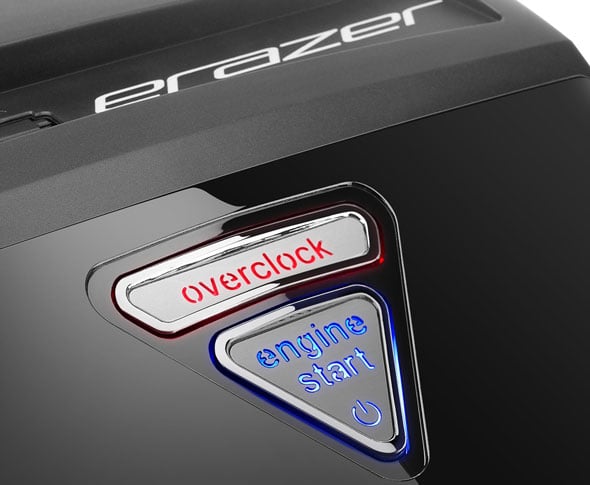

Lenovo first showed off its IdeaCentre Erazer X700 at the Consumer Electronics Show (CES) in Las Vegas earlier this year, and for whatever reason, it's taken the OEM eight months to start selling these machines. Given that it was shown off at the beginning of the year, that might explain why Lenovo is building these systems around Intel's X79 chipset with Sandy Bridge-E hardware.
That decision allows Lenovo to offer this series at a competitive price point compared to what the boutique system builders charge, but it comes at the expense of performance. As configured, the rig we received makes several compromises, including not taking advantage of the X79's ability to run RAM in quad-channel mode. Then there's the GeForce GTX 660 graphics card and 1TB of storage, both of which are decent but they won't have enthusiasts pumping their fists.
Compromises aside, the Erazer X700 is a respectable stab at offering gamers a dedicated gaming rig that looks the part. Our
configuration sells for $1,699 online and at Best Buy, though at the time of this writing, there's an eCoupon code on Lenvoo's website that brings the price down to $1,349. That's a pretty good value for a system that's capable of high-end gaming at 1920x1080. In many cases, Full HD gaming is possible even with all the eye candy turned on, though that's not always going to be the case.
For gamers who can live without cutting edge hardware, we feel Lenovo's IdeaCentre Erazer X700 offers a nice alternative to spending a premium on a boutique build. Furthermore, if you have the budget for higher end hardware, Lenovo will take your money and slap faster gear into this machine. Unfortunately, you can't customize these gaming boxes on Lenovo's website, though there are four different pre-configured setups to choose from, culminating in a $3,999 system that's currently marked down to $3,199.
| | |
- Boutique appearance at an OEM price
- Upgradeable
- Fair performance for the money
- Comes with a gaming grade keyboard and mouse
- Runs quiet
- Built-in Wi-Fi
| - Older generation foundation
- Needs another stick of RAM to run in quad-channel mode
- Sloppy cable management
- Can't customize before purchase
|
Source




